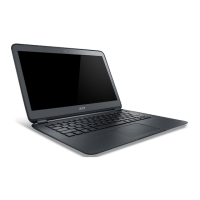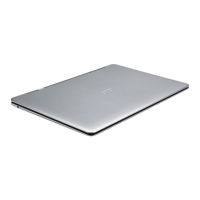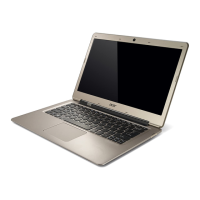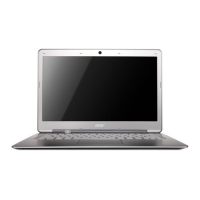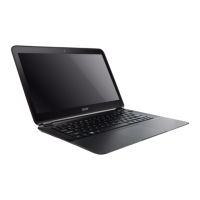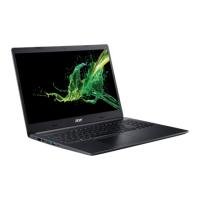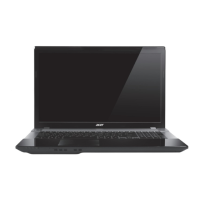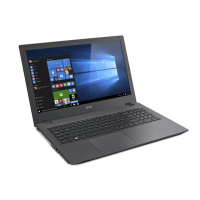
Do you have a question about the Acer Aspire Switch 10 and is the answer not in the manual?
| Form factor | Convertible (Detachable) |
|---|---|
| Product type | Hybrid (2-in-1) |
| Product color | Metallic, White |
| Stepping | C0 |
| Tjunction | 90 °C |
| Processor cache | 2 MB |
| Processor cores | 4 |
| System bus rate | - GT/s |
| Processor family | Intel Atom® |
| Processor series | Intel Atom Z3700 Series |
| Processor socket | BGA 1380 |
| Processor codename | Bay Trail |
| Processor frequency | 1.33 GHz |
| Processor cache type | L2 |
| Processor lithography | 22 nm |
| Processor manufacturer | Intel |
| Processor front side bus | - MHz |
| Processor boost frequency | 1.86 GHz |
| Processor operating modes | 32-bit, 64-bit |
| ECC supported by processor | No |
| Thermal Design Power (TDP) | 2 W |
| Motherboard chipset | - |
| Internal memory | 2 GB |
| Internal memory type | LPDDR3-SDRAM |
| Maximum internal memory | - GB |
| SSD capacity | The Solid State Drive's storage capacity in Gigabytes. |
| Storage media | SSD |
| Card reader integrated | Yes |
| Total storage capacity | 64 GB |
| Compatible memory cards | MicroSD (TransFlash), MicroSDHC |
| Number of SSDs installed | 1 |
| Display diagonal | 10.1 \ |
| Touch technology | Multi-touch |
| Display resolution | 1366 x 768 pixels |
| Native aspect ratio | 16:9 |
| Discrete graphics card model | Not available |
| On-board graphics card model | Intel® HD Graphics |
| On-board graphics card base frequency | 311 MHz |
| On-board graphics card burst frequency | 778 MHz |
| Wi-Fi standards | 802.11a, 802.11b, 802.11g |
| Bluetooth version | 4.0 |
| Charging port type | DC-in jack |
| DisplayPorts quantity | 0 |
| USB 2.0 ports quantity | USB 2.0 ports have a data transmission speed of 480 Mbps, and are backwards compatible with USB 1.1 ports. You can connect all kinds of peripheral devices to them. |
| Pointing device | Touchpad |
| Operating system installed | Windows 8.1 |
| Operating system architecture | 32-bit |
| Processor code | SR1SP |
| Processor ARK ID | 80270 |
| Processor package size | 17 x 17 mm |
| Intel Identity Protection Technology version | 1.00 |
| Battery life (max) | - h |
| Number of battery cells | 2 |
| AC adapter power | 18 W |
| Cables included | AC |
| Depth | 177.1 mm |
|---|---|
| Width | 261.6 mm |
| Height | 8.9 mm |
| Weight | 1170 g |
Overview of available guides like Setup Guide and Quick Guide for new users.
Essential advice for maintaining the computer and extending its lifespan.
Instructions on how to properly shut down the computer using different methods.
Precautions to protect the computer from damage and ensure longevity.
Guidelines for proper handling and care of the AC adapter to prevent damage.
Steps for safely cleaning and maintaining the computer's hardware.
Identification and description of components visible on the front of the computer.
Identification and description of components on the bottom of the computer.
Identification and description of ports and buttons on the sides of the computer.
Explanation of the different LED lights and their meanings for system status.
Illustration and labeling of the keyboard's front layout and keys.
Explanation of the touchpad's basic functions and how to use it for navigation.
Identification and description of ports located on the right side of the keyboard.
Step-by-step instructions for connecting and disconnecting the keyboard to the tablet.
Explains Caps Lock, Num Lock, and Scroll Lock functions, and embedded numeric keypad usage.
Description of special key combinations (hotkeys) for quick access to computer functions.
Details on specific keys that perform Windows-specific functions for enhanced productivity.
Fundamental gestures for cursor movement, clicking, and selection using the touchpad.
Advanced touchpad gestures for navigation and application control using multiple fingers.
Step-by-step process to create a full system backup for disaster recovery purposes.
Overview of methods to recover the system, from minor fixes to full resets.
Instructions for reinstalling pre-installed software and device drivers to resolve issues.
Steps to reset the computer to its original factory state, erasing all data.
Guide to connecting to wireless networks (WLAN) and managing network settings.
Process for pairing new Bluetooth devices with the computer for data transfer.
Steps to modify the boot order of devices in the BIOS utility.
Instructions on setting up passwords within the BIOS utility for system security.
Explanation of different password types (Supervisor, User, Boot) and their security functions.
How password prompts appear and the procedure for entering passwords correctly.
Tips and settings to reduce power consumption and extend battery life.
Step-by-step instructions for connecting the AC adapter and charging the battery.
Advice and tips for maximizing battery operational time and prolonging its overall life.
Actions to take when the battery low warning appears to prevent data loss.
Step-by-step guide on how to properly insert a memory card into the reader.
Safe procedure for ejecting memory cards to prevent data corruption.
Information on using the headphone and microphone ports for audio input/output.
Troubleshooting steps for power-on, boot-up, and blank screen issues.
Solutions for no audio output and non-responsive keyboard problems.
Information on restoring system settings and requesting technical support.
Useful tips and shortcuts for navigating and utilizing Windows 8.1 features.
A table listing common error messages and their recommended corrective actions.
Strategies to protect the computer from viruses and online threats using security software.
Advice on selecting an ISP and the steps involved in getting connected to the internet.
Overview of different methods for connecting to the internet, including Dial-up, DSL, Cable, and 3G.
Explanation of local area networks (LAN) and wireless networks (WLAN).
Guidelines for creating secure passwords and best practices for password management.
Tips for safely sharing personal information online and avoiding scams.

